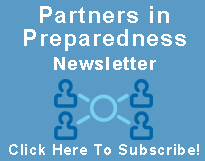
Click Here for information on upcoming training opportunities and community events.
Partners in Preparedness
Two Storms, One Response
J. W. Thaxton
Gwinnett County Office of Emergency Operations
Two significant winter storms only weeks apart challenged Georgians with stranded motorists, power outages, and fallen trees – to name a few. Many organizations across Gwinnett County worked collaboratively, preparing for and responding to the 2014 winter storms. The coordination and cooperation among organizations was nothing short of incredible. Over and over again we see a direct relationship between disaster response outcomes and a community’s ability to work together.
The Gwinnett County Emergency Operations Center (EOC) was opened for both events to help facilitate collaboration among organizations. While the EOC is important, the people working in the EOC are what really drive an effective response. In the first event, the EOC was activated for 39 hours. It was activated for 70 hours in the second event. Emergency Operations Centers are designed to accomplish two main objectives: 1) provide a common operating picture through situation awareness and 2) establish strategic objectives and prioritize resources accordingly. In other words, EOCs help get everyone singing off the same sheet of music and allow us to respond as a community rather than individual organizations.
Leaders from county departments, city agencies, and private organizations gathered at the EOC to ensure everyone was informed about the event and what was taking place in departments around the county. Organizations worked to take care of each other and the residents of Gwinnett County in numerous ways. Even if a specific task was outside an organization’s primary role, all were ready to meet the challenge. One example was the county Department of Water Resources using its equipment and personnel to help Gwinnett Medical Center clear snow and ice from their parking lots and access routes.
Although Gwinnett County’s response to the winter storm is considered a success, we can always find ways to improve in large-scale responses. In a series of debriefings with organizations involved in the response, one of the challenges presented involved our healthcare partners. Many people require ongoing medical treatment such as dialysis for a health condition. During the second snow storm, some medical facilities were closed and patients of others were unable to get to their appointments by their normal means. Emergency managers across Georgia were challenged by this type of situation.
The Gwinnett County Office of Emergency Management encourages healthcare facilities to work with their patients and develop viable emergency plans. Local resources – including ambulance service providers – are often taxed during inclement weather events. Additionally, hospitals are not equipped to handle a large number of patients requiring dialysis treatment. Preparedness plans for transportation of critical staff and patients to and from healthcare facilities should be made before an event occurs.
Overall, Gwinnett County’s ability and willingness to work together was the single most influential factor. It is important to walk away from large events with the realization of your organization’s dependence on others.
Remote Communications
Gwinnett, Newton and Rockdale
County Health Departments
The roads are iced over. There are trees down. No one is going into the office today, because it is closed. But you work in Emergency Preparedness and need to stay in touch with your team and community partners. What do you do?
Fortunately during the 2014 winter weather events, there was not the mass loss of power Atlanta usually experiences with ice and snow. This made staying connected so much easier. And the technology available today means we can be connected no matter where we are.
Equipment used by Emergency Preparedness staff includes computers, tablets, land/mobile phones, SouthernLinc radios and HAM radios. This communication gear and the access it provides become vital when everyone is spread across the county, state or country.
Email is good for limited two-way communication with a specific group. And press releases to local media can help spread your message. But nothing gets information out faster than digital communications. Websites and social media outlets make information available to more people than you can ever email. And, unlike broadcast media, it is available any time someone visits your site or page.
Social media is also good for monitoring information from the residents in your community. What are they saying? What are they looking for? It’s also a great place to see what your partners are saying. If you don’t follow your partners on Twitter or Facebook – now might be a good time to start. Reposting and retweeting messages from your partners helps get the word out even faster.
To help you stay in touch with the Emergency Preparedness community, there are several tools:
WebEOC: This is a Web-based emergency operations center (EOC). Through WebEOC you keep track of what is happening state-wide and in your local area. It tracks items such as significant events, situation reports, personnel status, and requests for resources. It is where you will find press releases, along with information on shelters and points of dispensing. There is a statewide-EMA site (GEMA), as well as a Public Health (PH) site. There is also a Fusion board where both the GEMA and PH information can be seen.
GHA911: This website helps Georgia hospitals and healthcare community, as well as local and state agencies, stay informed about vital news and information related to disaster readiness. The site offers the fused WebEOC, tools and resources to assist the healthcare community in disaster preparedness and mutual aid planning.
We were fortunate that we did not lose power during this storm, as many of these resources would not have been available from a remote location – unless you had a generator.
So, the last tool in our Emergency Preparedness communications kit is an external battery. These devices can charge a mobile phone or tablet several times. They are cost effective and portable. The Health Department EP team highly recommends them.
Second Helpings
Jack Harper
Gwinnett, Newton and Rockdale County Health Departments
The second “Snowmageddon” that we had this year was completely different from the first one in January – the one that stranded Atlantans on local roads and interstates. Although the Governor and FEMA accepted responsibility for that first disaster, responsibility also needs to be shared with YOU and ME. We’ll look at the 2nd event (the one in February) but first let’s review what happened in January.
January Event: The weathermen properly predicted the conditions and warned us that this could be bad. We usually just wait and see how bad things really get, and then plan our response. Most times our weather becomes more severe later in the day. This time it came in early afternoon. We were all at work and school when the decision was made to shut down and head home. The way this occurred meant that in addition to regular Atlanta traffic, we put too many additional cars and buses on the road at the same time. You can blame the leadership of the schools, the government, and business for releasing people all at once. They should have done better – right? But think about it: you went to work with a severe weather condition announced, you sent you kids to school and you might not have stocked up on the basic survival supplies and gassed the car the night before. Would this be correct?
February Event: For the second severe winter storm, we all took notice and did things differently. We were all prepared and ready to survive whatever Mother Nature threw at us. Government, schools and business took preemptive measures. How did it go? Did we learn the lessons we should have known earlier?
My experience at the EOC:
Let me diary my 36 hours at the Gwinnett Emergency Operations Center (EOC) during the second (February) event. I am an emergency planner for the health department – working to prepare for, prevent and mitigate public health disasters. Sometimes events follow the norm and things turn out as expected. Other times, you have to be prepared to change course at a moment’s notice.
As part of the healthcare community, the Health Department was called to fill our role in the EOC addressing emergency situations and identifying resources. I have taken courses, studied, & exercised the actions to take for situations like this. But up to this point, I had never been called in for a real emergency. This was new and exciting. I would put on my Superman suit and help our citizens. Mid afternoon my boss said to come to the EOC.
Because I preach emergency preparedness, I grabbed my “To-Go-Kit” with all the things I felt I could need. We were quickly briefed on current conditions and what was expected. The EOC facility is well equipped for any major response. Approximately 20 other county partners began to discuss the “what-ifs” for this event. Public Health has primary responsibility with mass healthcare and secondary responsibility with sheltering. At this time, neither was required.
Night came and we could see that this event would go on for many hours. I was asked if I could stay in the EOC overnight, representing Public Health. I went home, ate and got my air mattress and returned. We realized the weather was more severe to our south and those residents might have icing and power failures, so we began looking for shelters that might be used. We soon realized that most locations on our shelter list, mainly churches, did not have generators for backup power. We asked: Should we open a shelter for people without power, if the shelter might lose power? Our Gwinnett County Schools, always a great partner, said they could open South Gwinnett High School, which had backup generators.
Because the snow and icing condition did not disrupt electrical power, all involved decided that this was a “shelter-in-place“event and no shelters would need to be opened.
What did we learn?
Take heed when warned of severe weather: prepare for your family and don’t depend on others to do for you. Because we were not as prepared the first time, it affected our response the second time.
If you are a healthcare partner, please consider meeting and exercising with us. Become familiar with the Incident Command System that we follow to improve coordination and control in an emergency. And finally, think through your organization functions and how they could be impacted in an emergency and what preparations you should make. I am proud of the leadership in Gwinnett County and I hope you will join us in our preparation.
Click Here for information on upcoming training opportunities and community events.


